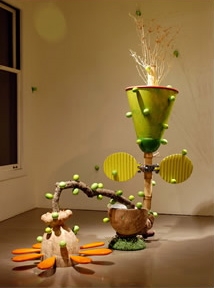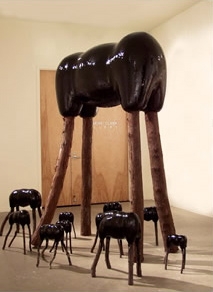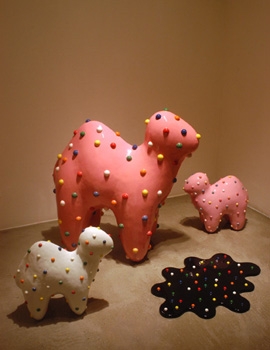Feature: Reviews
Walter Robinson
- Catharine Clark Gallery and San Jose Museum of Art
- San Francisco and San Jose
- July 1-31, 2004 and July 24-October 31, 2004
Since the mid-nineties, Walter Robinson has made his sculpture a vehicle for uncanny mimesis and material play. His psychologically laden early work, first shown at Morphos Gallery (which later became Catharine Clark Gallery) consisted of coded tableaux and glyph-like wooden forms made of carved, painted wood skillfully sutured together in equal parts of representation and distortion. When Robinson united rubbery-looking tools with cartoony body parts, the polychromed wood seemed to take on an animated, clay-like plasticity. Now, as then, his material inventiveness and seamless fabrication tends to disappear into the narratives he presents; in that sense, Robinson’s tongue-in cheek “anxious objects” seemed to have much in common with Arneson’s funk-derived icons and Richard Shaw’s trompe l’oeil masterpieces.
Out of the Woods
In 1998, when Robinson was awarded a six-week residency at the Djerassi Foundation, he shifted dramatically from illusionary painted work to large-scaled dynamic structures using wood he found on the Djerassi grounds. Although much of that new work was more abstract and conceptual, with rougher surfaces that revealed more of their material sources, Robinson’s propensity for fabricating playful referential elements from available materials persisted. The comically exaggerated scale of Gridlock (1999)—his giant interlocking Tinker toys carved from sections of logs joined by handmade dowels the size of small tree trunks—produced a sense of displacement that rendered his skillful facture nearly invisible.
In late 2000 Robinson began fabricating animal-based forms that combined the raw wood elements influenced by his residency with the fluidity and finish that characterized his earlier representational work. The animal pieces started with Tarpets, a series of four-legged, headless carved wood creatures painted with glossy, tarry-looking black epoxy resin. Propped precariously on spindly stick legs made of bare branches deftly chosen for their animated line, many of the invented creatures appeared to be stumbling in a state of near collapse. Their headless shapes, implying blindness and lack of consciousness, evoked a powerful tone of pathos. For a 2003 installation at the San Francisco Museum of Modern Art Artists Gallery, Robinson arranged these smaller forms beneath a large standing figure with drips of nipple-like black resin hanging down from its belly. The scale shift between the large figure and the smaller ones—as between the viewer, similarly dwarfed below the larger form—suggested a monstrous and ominous mother, evoking formal comparisons to Louise Bourgeois’s sinister spiders.
Naked Lunch
Robinson followed his Tarpets with a series of Meaties, headless dachshund-shaped creatures coated with fleshy pink resin. The compact flesh-colored bodies resembled naked bundles of prepackaged meat cheerfully delivering themselves on their short stick legs; in an interview, Robinson described them as commentary on the disconnect that occurs between consumers and the neatly packaged products that they buy. However, the naked forms, symbolically neutered of personality, distinction or consciousness by their headless state, also hinted obliquely at the dehumanizing influences of sexual objectification in contemporary culture.
Cookie Break
This summer Robinson showed related installations in two Bay Area venues, the San Jose Museum and the Project Room at Catharine Clark Gallery. The standout pieces in both spaces contained scaled-up renditions of frosting-coated pink and white animal cookies executed in epoxy-coated Styrofoam. In both the museum installation and the gallery tableau, the illusionary magic of Robinson’s oversized cookies (replete with multicolored sprinkles) evoked audible exclamations of recognition from viewers as they approached the iconic shapes. If they were meant as nothing more than skillful evocations of a familiar childhood icon, Robinson accomplished that task persuasively. However, social critique and emotional resonance appear to be still very much on Robinson’s mind, and now, as in the past, deeper examination reveals that he has embedded more fiber into these pieces than their sugar-coated exteriors initially suggest.
The Pause That Refreshes
Quench, installed in the Project Room at Catharine Clark Gallery, was comprised of freestanding renderings of three frosted, besprinkled camels (a mother with two babies) clustered around a black puddle in which more colored sprinkles floated. The tableaux of a Candyland oasis, in which the puddle reads as a pool of crude oil where the shiny creatures were drinking, offered another parable of consumer excesses. In context, Robinson’s cheerfully pneumatic, glossy creatures were perfect surrogates for shiny SUV’s, and for the escalating appetite for illusory glamour, novelty, and surface that a consumer-oriented culture breeds.
Nice Doggy
Robinson’s Sparkle Pups, headless glittery dogs finished in punky metal flake colors, are penned together in a corner on the San Jose Museum’s mezzanine. Facing outward with alert, defensive postures and muscular stances, their glittery surfaces sparkling like nail polish or newly waxed high-performance cars, the sexual connotation of their curved contours is unmistakable. As with Robinson’s Meaties, their rounded rumps suggest commoditized sexuality, but there is the further implication of a kind of glamorized unconsciousness and unbridled animal instinct in their presence. Facing then, we can’t be sure of their intent: they could be friendly show dogs, bred and groomed to surface perfection, or a pack of killers poised for attack. In that sense the Sparkle Pups embody a terrifying pack of unexamined impulses and unconscious drives, dressed up in desirable, attractive packaging.
Uncaged
With their pneumatic, barely demarcated contours (lion, camel, hippopotamus, buffalo) and glistening, deliciously colored surfaces, the twenty-six cookies parading across the mezzanine wall in the untitled installation at the San Jose Museum are as instantly recognizable as Warhol’s soups cans. Two black animals stand out starkly among the pink and white herd, making implicit comment on race the first reading. In an interview, Robinson admitted that, growing up in suburbia with a foreign mother, he had encountered some racial prejudice and a sense of otherness. While acknowledging that the multiple readings inherent in the installation that could include racial commentary, he pointed out that creative people, particularly in their desires to generate in a society directed toward consuming, experience a sense of “otherness” or difference in relationship to the broader culture. In his view, putting two black animals in the wall piece gave it a more optimistic, or “hopeful” sense, that that these two “outsiders” might eventually find each other. In this piece, as has been the case with Robinson’s ongoing material investigations, emotional depth lies just beneath seamless surfaces.



